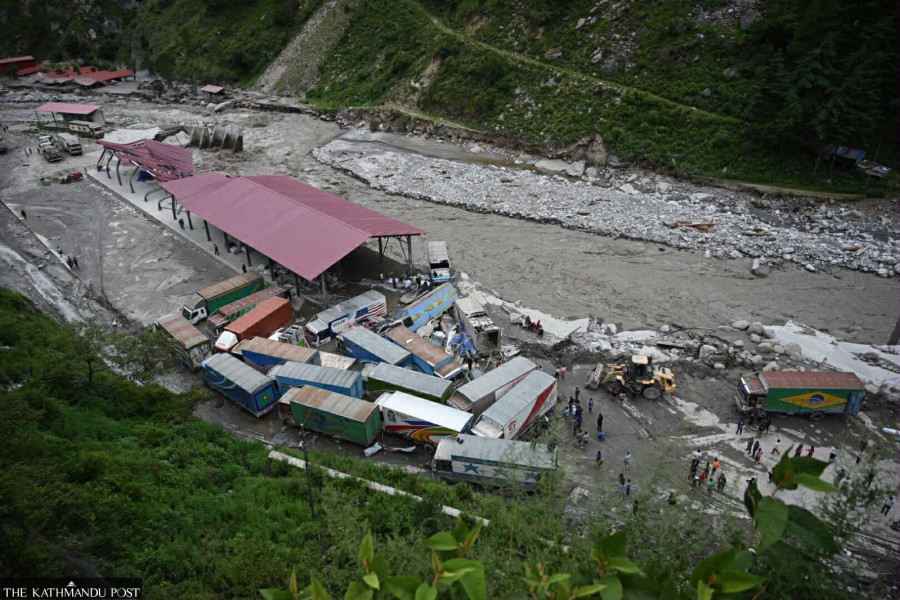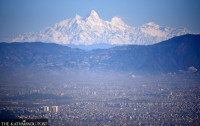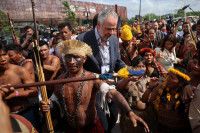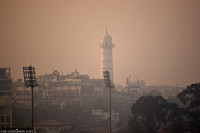Climate & Environment
Nepal faces a double whammy—dry spell in Tarai, floods in mountains and hills
The country is reeling from an extreme climate crisis, as hundreds of farmers in the Tarai are unable to plant paddy.
Arjun Poudel
Seven out of the eight deep borings installed for irrigation in ward 4 of Bara’s Pheta Rural Municipality have dried up due to a prolonged dry spell during the mid-monsoon. The transformer of one of the borewells, which was functioning, was stolen.
The canals under the Narayani Irrigation System that were filled with river sediments years ago are yet to be cleared, and the municipality’s excavator, which could have been used to clean the canals, is defunct.
“Farmers in our areas have not been able to plant paddy this year,” Wakil Prasad Yadav, ward chair, told the Post over the phone from Birgunj. “I am also a farmer, and we do not know if we could cultivate our land this monsoon. There is no rainfall.”
This is a common refrain among tens of thousands of farmers in the entire southern belt of the country who have no irrigation to cultivate paddy in the rainless planting season.
At a time when farmers in the Tarai belt gaze anxiously at the sky, hoping for rainfall, people in hills and mountainous regions have been affected by landslides and floods.
Since the start of the monsoon this year, around two dozen people have already succumbed to landslides and flooding. Several others have been injured and are missing in monsoon-related disasters. Properties and infrastructure worth billions of rupees have been either washed away by floods or buried in landslides.
Locals in the mountainous region say that the weather has become so erratic that even light rainfall triggers floods. Scores of glacial and supraglacial lakes could burst any time due to the melting of ice accelerated by global warming. At least nine people were killed, and 19 others are still missing, in the Bhotekoshi flood triggered by a previously unnoticed supraglacial lake formed in Tibet above Rasuwagadhi.
“You never know when it’ll rain in the mountains,” said Krishna Gurung, chair of Sirijangha Rural Municipality’s ward 8 in Taplejung district. “The rivers rise suddenly, and by the time you realise it, it’s already flooded.”
Meanwhile, withering paddy saplings in the seedbeds worry farmers in the Tarai region and raise fears of an impending food shortage.
The provincial government of Madhesh has declared the entire province a drought-hit zone and started supplying drinking water using fire trucks and tankers, but that, too, does not solve the problems of farmers.
Nepal is one of the world’s most vulnerable countries to the climate crisis. For over a decade, it has witnessed multiple extreme weather events. On July 8, the country witnessed two glacial-originating floods in Rasuwa and Upper Mustang.
It also witnessed glacial lake outburst incidents in Humla district in the third week of May. Last year, Thame village of Solukhumbu saw a massive flood triggered by a glacial lake outburst. In the past one and a half months, there have been three glacial lake outbursts in the country.
Experts say recurring extreme weather events, such as excessive rainfall in a short span, prolonged rains after the monsoon, frequent glacial lake outbursts, droughts, and above-average winter temperatures, show that the country is bearing the brunt of the climate crisis.
What alarms them is that despite the emergency caused by the climate crisis, the country is not ready to cope with it. According to them, neither the right infrastructure is being built to weather challenges, nor are systems in place to address drought-like conditions. In the Bara case, the irrigation canal could have been cleared before the start of the monsoon, and a transformer arranged for as per the urgency.
Problems created by the climate crisis present nothing short of an emergency, said Manjeet Dhakal, a climate expert. “To address the climate crisis, the entire system of government must coordinate and cooperate.”
Studies show that around 200 people die in climate-related disasters every year.
Drought in mid-monsoon in the Tarai region, which is also the country’s food basket, not only hits the farmers but also the overall economy.
Nepal has been experiencing changes in temperature and precipitation at a rate faster than the global average, according to studies. Evidence indicates that the maximum temperature in Nepal is rising at a greater rate (0.05 degrees Celsius per year) than the minimum temperature (0.03 degrees Celsius per year).
Scores of studies and scientific analyses over the decade and, more recently, the IPCC report, have warned that Nepal is one of the most vulnerable countries to the climate crisis and business-as-usual approach isn’t sufficient to tackle the adverse impacts of the crisis.




 6°C Kathmandu
6°C Kathmandu










